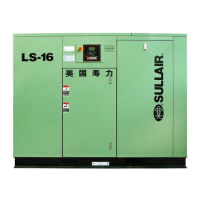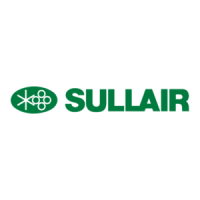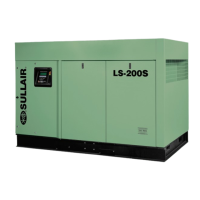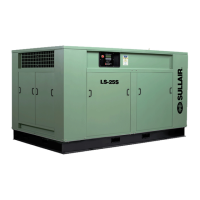Section 1
SAFETY
3
C. Operate the compressor only in open or ade-
quately ventilated areas.
D. Locate the compressor or provide a remote inlet
sothatitisnotlikelytoingestexhaustfumesorother
toxic, noxious or corrosive fumes or substances.
E.
Coolants and lubricants used in this compressor
are typical of the industry. Care should be taken to
avoid accidental ingestion and/or skin contact. In
the event of ingestion, seek medical treatment
promptly. Wash with soap and water in the event of
skin contact. Consult the compressor operator’s
manuallubricationsectionfor informationpertaining
to compressor fluid fill.
F. Weargogglesorafullfaceshieldwhenaddingan-
tifreeze compound to air line anti--icer systems.
G.
If air line anti--icer system antifreeze compound
enters the eyes or if fumes irritate the eyes, they
should be washed with large quantities of clean wa-
ter for 15 minutes. A physician, preferably an eye
specialist, should be contacted immediately.
H. DONOT storeairlineanti--icersystemantifreeze
compound in confined areas.
I. The antifreeze compound used in air line anti-
freeze systems contains methanol and is toxic,
harmful, or fatal ifswallowed. Avoidcontact withthe
skin or eyes and avoid breathing the fumes. If swal-
lowed, induce vomiting by administering a table-
spoonofsalt, ineachglassof clean,warmwaterun-
til vomit is clear, then administer two teaspoons of
baking soda in a glass of clean water. Have patient
laydownand covereyes to excludelight.Callaphy-
sician immediately.
1.8 ELECTRICAL SHOCK
A.
This compressor should be installed and main-
tained in full compliance with all applicable Federal,
State and Local codes, standards and regulations,
including those of the National Electrical Code, and
alsoincludingthoserelativetoequipmentgrounding
conductors, and only by personnel that are trained,
qualified and delegated to do so.
B. Keep all parts of the body and any hand--held
tools or other conductive objects away from ex-
posed live parts of electrical system. Maintain dry
footing, stand on insulating surfaces and DO NOT
contact any other portion of the compressor when
making adjustments orrepairs to exposed liveparts
of the electrical system. Make all such adjustments
or repairs with one hand only, so as to minimize the
possibility of creating a current path through the
heart.
C.
Attempt repairs in clean, dry andwell lighted and
ventilated areas only.
D. DO NOT
leave the compressor unattended with
open electrical enclosures. If necessary to do so,
thendisconnect,lockoutandtagallpoweratsource
so others will not inadvertently restore power.
E. Disconnect, lock out, and tag allpower at source
priortoattempting repairsoradjustments torotating
machinery and prior to handling any ungrounded
conductors.
F. Dry test all shutdown circuits prior to starting the
compressor after installation.
1.9 LIFTING
A. If the compressor is provided with a lifting bail,
then lift by the bail provided. If no bail is provided,
thenlift by sling.Compressors to beairlifted byheli-
coptermustnotbesupportedbytheliftingbailbutby
slingsinstead. In anyevent, lift and/orhandleonlyin
fullcompliancewithFederal, State andLocalcodes.
B.
Inspect points of attachment for cracked welds
and for cracked, bent, corroded or otherwise de-
graded members and for loose bolts or nuts prior to
lifting.
C. Make sure entire lifting, rigging and supporting
structure has been inspected, is in good condition
andhasa rated capacity of atleast the weight ofthe
compressor. If you are unsure of the weight, then
weigh compressor before lifting.
D. Make sure lifting hook has a functional safety
latch orequivalent, andis fully engaged andlatched
on the bail or slings.
E. Use guide ropes or equivalent to prevent twisting
orswingingofthecompressoronceithasbeenlifted
clear of the ground.
F. DO NOT attempt to lift in high winds.
G.
Keepallpersonneloutfrom underandawayfrom
the compressor whenever it is suspended.
H. Lift compressor no higher than necessary.
I. Keep lift operator inconstant attendance whenev-
er compressor is suspended.
J.
Set compressor down only on a level surface ca-
pable of safely supporting at least its weight and its
loading unit.
K.
When moving compressors by forklift truck, uti-
lizefork pockets ifprovided. Otherwise, utilizepallet
if provided. If neither fork pockets or pallet are pro-
vided, then make sure compressor is secure and
well balanced on forks before attempting to raise or
transport it any significant distance.
L. Make sure forklift truck forks are fully engaged
and tipped back prior to lifting or transporting the
compressor.
M.
Forklift no higher than necessary to clear ob-
stacles at floor level and transport and corner at
minimum practical speeds.
N.
Make sure pallet--mounted compressors are
firmly bolted or otherwise secured to the pallet prior
to attempting to forklift or transport them. NEVER
attempttoforkliftacompressorthatisnotsecuredto
its pallet, as uneven floors or sudden stops may
cause the compressor to tumble off, possibly caus-
ingseriousinjuryorpropertydamageintheprocess.

